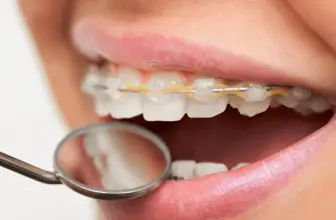Skin Moles to Worry About – A Complete Guide With Skin Moles Pictures
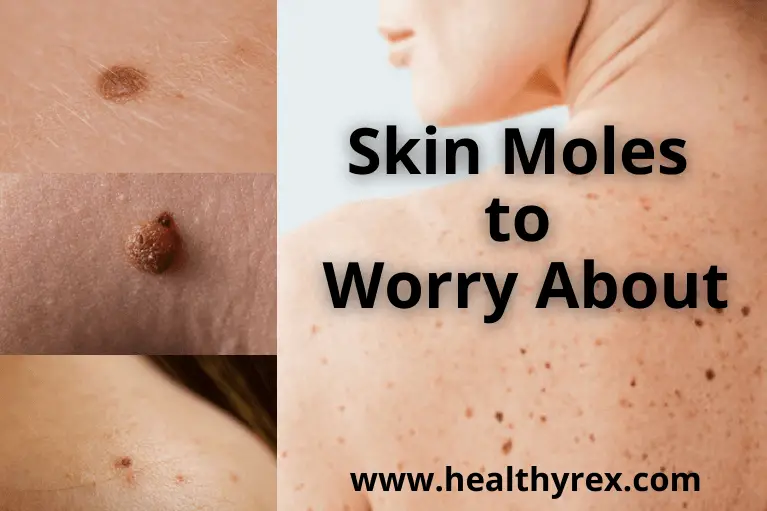
Moles are colored and small spots on the skin. Many people have them, so the question arises which type of skin moles to worry about. Let me clear it for you; there is nothing to be worried about moles unless they are changing color, shape, or size.
Symptoms
Moles come in different sizes, shapes, and colors, but typical moles are brown in color spots.
-
Color and texture
Moles can be tan, brown, red, black, blue, and sometimes pink. They can be wrinkled, smooth, raised, or maybe flat. In some cases, they may have certain growths on them.
-
Shape
Most moles are round and maybe oval.
-
Size
Generally, moles are less than 6 millimeters in diameters that is the size of a pencil eraser that is approximately ¼ of an inch. In rare cases, moles are present since birth; compared to the other moles, they are bigger and cover a large area of your torso, face, or maybe the limb.
Moles can develop anywhere on your body, including your armpits, scalp, under your nails, and maybe in between your toes and fingers. Most people have 10 to 40 moles on their body, and these develop by the age of 50.
Adolescence hormonal changes and pregnancy may result in making your moles larger, darker, and more prominent.
-
Skin Moles Pictures
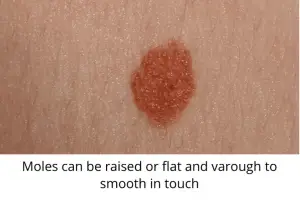
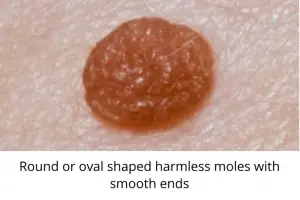
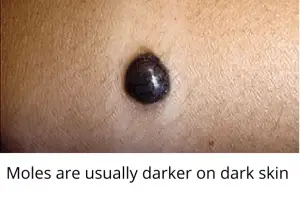
Your genetics determines most moles, but the use of a tanning bed and sun exposure can result in new moles and even make your current moles darker. During pregnancy and puberty, moles can also change.
7 Homemade Recipes for Removing Skin Tags Check Here.
Different types of moles
Moles are usually pigmented and a small spot on the skin. They can be raised or may be flat and even vary in their appearances. There is a wide variety in the types of moles you can have. Mostly they are classified into the following three types.
-
Congenital moles

The types of moles that are present since your birth are known as congenital moles. These moles are classified by their size, whether small, medium, or large. Among these sizes, only large congenital moles with a greater than 20mm size have a significantly high risk of turning this mole into a cancerous one.
-
Acquired moles

Mostly maximum people have acquired moles, which means they got these moles after birth. They are typically not large and are even smaller than a pencil eraser, and they have a symmetrical border and pigmentation. These acquired moles usually don’t develop into skin cancer.
- Atypical moles

Dysplastic nevi, also known as typical moles, have irregular borders, multiple colors, and irregular borders. In these moles, pigmentation is not even and can have a focal darker area. Numerous atypical moles generally run in families. The risk of skin cancer increases with the number of moles you have.
Causes of moles
When our skin cells grow in the form of a cluster instead of spreading evenly throughout the skin, moles are known as melanocytes, and they produce the pigment that gives skin its natural color. Your moles may darken during your teens, pregnancy, or maybe due to the exposure of sunlight.
In simple words, moles are the abnormal growth of cells in your skin; however, remember that all abnormal growths are not always cancer. Generally, moles are not rare; according to the American Academy of Dermatology (AAD), almost every person has an average of 10 to 40 moles.
As in the case of congenital nevi, some people are born with moles. You can also develop moles, most probably in your childhood or maybe in your adulthood. The majority of the moles on your body are harmless, but there are still chances that some mole can be cancerous.
Thus it is essential to go to a dermatologist if you find your mole suspicious.
The biggest problem of moles
Melanoma
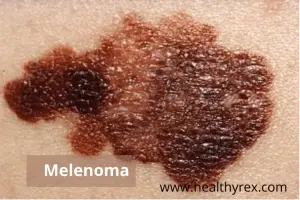
Undoubtedly numerous moles are harmless but don’t take a risk by ignoring them. As melanoma is the most severe skin cancer, and it begins with a simple skin mole. If you are in your thirties or maybe older, then a new mole or maybe a changing mole can be the symptoms of melanoma.
That’s the main reason to know that what your moles exactly look like, its shape, color, or any changes it is currently showing. If you get your melanoma in the early stages, it is highly treatable.
You can spot melanoma in the early stages if you know.
- Where you have your moles
- The shape and texture of your moles
The risk factor of moles
Not only our inherited genes but the amount of sun exposure, especially in our childhood, are some of the significant factors that determine the number of moles in our body. The skin that is more exposed to the sun will automatically have more moles. Although these moles are not only restricted to your exposed part but can also occur in your protected areas.
Freckles and mole both are darker than the surrounding skin color. The texture of moles varies, it may flat or rose, but freckles are always flat. Freckle occurs on the skin due to the increased amount of melanin that is a skin pigment.
Whereas mole is common in people sensitive to freckles. Freckles are tan flat spots. They typically appear during the sunny month and have a light brown or reddish appearance typical in fair skin complexion persons.
Most people with red or blonde hair and blue or green eyes are usually more prone to these kinds of skin spots. Regular use of sunscreen, sun avoidance, and sun protection helps suppress the appearance of some types of freckles and moles. Moles are not skin type-specific but occur in all races such as African, Asian, or Caucasian. Even some animals also have a mole on them.
Can a baby have a mole?
Yes, a mole can be present at birth or can appear gradually after the birth period. Some children continuously develop moles through their teens into their young adulthood. Moles show a sight growth with respect to the growth in the body.
Congenital moles are the moles present at birth and during fetal development. Moles can also arrive on your kin because of the genital factor and environmental factors like your exposure to the sun.
Do adults get a mole?

Yes, a mole can still appear on your skin when you are in adulthood, but many moles arise on your body in the first year of your life. Undoubtedly, the maximum number of moles you have will have to arrive in your early years, but they typically peak in your second or third decade of life around about 35.
Many adults develop non-moles growths like liver spots, seborrheic, lentigines, freckles, keratoses in later adulthood. The moles that appear on your body after age 35 require your observation, comparative medical evaluation, and possible biopsy.
It is essential that you observe a new mole formation on your body and then consult your doctor about it. As it can be a sign of early melanoma and abnormal mole. Especially if your mole looks different from the others and bleeds or itches, then go to your dermatologist immediately.
Some problems with moles
Although melanoma is a serious problem a mole can have, but it is not the only one. A mole has some other issues as well.
- It can be irritated easily.
- It can damage your looks, and it may look unattractive on your face.
Usually, a harmless mole arises a little above your skin. If jewelry or your clothing gets caught in your mole or rub against it, it can result in irritating the mole. The skin around your mole may feel uncomfortable.
If you have a raised mole on your skin, you may cut the mole, resulting in bleeding by a shave. Because of this, your mole can be troublesome. Many people think moles make them unattractive, and it is a big problem for them. If you think your mole is a problem, then let your dermatologist deal with it so that he can decide whether it is a problem or not?
Is it dangerous when a mole is getting bigger?

New but enlarging moles can be dangerous, and a dermatologist is the one who can observe it efficiently. In particular, before the age of 20, regular moles sizes may increase slightly, but as the people get older, harmless moles show no change in size.
A mole that increases in size is not always cancerous because enlargement alone doesn’t mean it is malignant. After examination, a doctor is the one who can efficiently describe whether a mole is malignant or not.
There are some moles that during pregnancy become large in size and dark in color. Regular moles have little or no health risk essentially; thus, it is not necessary to remove all of your moles. Maximum moles are not cancerous and even don’t become malignant in the future.
It is essential to have a periodic evaluation and medical monitoring of your moles so that your doctors can understand which mole needs removal. And if you have a growing, bleeding, changing, symptomatic, and new mole, your doctor may find it necessary to remove your mole.
Self-checks for skin
Regular checks of your skin help you to spot the mole changes. More than half of skin cancers occur on such body parts that you can easily observe. It is usually not common to find melanoma on the sun-protected body parts of your body.
In women, the most common body sites for melanoma are their legs and arms. On the other hand, their common body sites are their trunk, neck, head, and back for men. Non-Caucasians have a generally lower risk of melanoma.
- The palms
- The soles
- In between fingers and toes
- Under your fingernails or toenails
Self checkup can help you to avoid future health risks at their starting and eradicate their causes.
Skincell Pro
Skincell Pro is a mole and skin tag corrector serum. Skincell Pro is a natural solution, fast and easy solution for unwanted moles and pesky skin tags in the comfort of your own home! Skincell Pro doesn’t have side effects. After its use, there will be no trace that a mole had existed there. It is one of the most affordable and pain-free methods you can have. Visit the official website of Skincell Pro.
Skincell Pro Review – Everything You Need To Know Before Try, Read Here.
When to see a doctor
If you have a mole in your late adulthood, then you should go to see your doctor. Doctors recommend having a regular skin checkup at least once a year. If you have a risk for melanoma, your doctor may recommend a skin check after every six months or maybe less.
There are three different skin cancers, and all of them look different from each other. Following ABCDE rules that show you changes that indicate you might have melanoma, severe, and even fatal skin cancers.
In skin cancer, there are changes in your skin moles, even if these are not as same as motioned here, but there are constant changes. If you doubt your skin changes, then consult your doctor before it reaches a severe stage. A timely diagnosis is essential.
-
A – Asymmetry
There may be a difference in the two halves of a mole.
-
B – Border
The edges of the area may be blurred or irregular and sometimes show apparent symptoms.
-
C – Color
Color may be uneven and can have different brown, black, and even pink shades.
-
D – Diameter
The maximum mole having melanoma is at least 6mm in diameter.
-
E- Expert
It is essential to see an expert for a complete skin check and deciding on mole removal. A dermatologist is the most expert person who can quickly diagnose skin cancer.
If you have a mole that meets the melanoma criteria described above, I would recommend seeing your doctor immediately. The good news here is that the early melanoma detection maximizes the chance of the person to defeat his disease and have a new start towards his healthy life.
The survival rate of melanoma is 93%, with the help of early detection. A dermatologist is undoubtedly the best option for the person who wants to remove his mole that he feels to be unattractive or irritated.
Mole removal: Why a dermatologist should do it
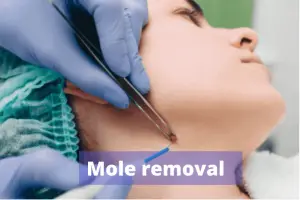
If you are thinking of getting rid of your mole with the help of home remedies, then consult your doctor as it can do more harm than good. Your homemade paste can cause allergic skin reactions to your skin and may leave you with rough and red skin. It can also result in severe infection or scar.
Some people prefer tattooing over their mole, and it is not a great choice. If melanoma develops on those moles in later years, it will become hard to diagnose in their early days. If it is not diagnosed early, it can make their chances of treatment less.
A dermatologist can easily remove maximum moles without any downtime within his office. It would help if you preferred a dermatologist for your mole removal because a dermatologist can send it to the laboratory to look for the sign of melanoma.
The complete checkup of moles for melanoma is essential, especially if you have its symptoms. If melanoma is diagnosed, you can get timely treatment, and if not, you can at least get a piece of mind.
Is it possible to prevent moles?
As it is not possible to change our genetics; thus, we cannot prevent all of our moles. But by avoiding the maximum sun exposure, we can prevent some. Here is a small list of preventions related to valuable sun exposure.
- By using Wide and brimmed hats of almost 6 inches.
- Staying indoors and seeking shades.
- Try to avoid peak sun hours, especially from 10 a.m. to 4 p.m.
- Use sunscreen with SPF means sun protection factor.
- Maximize the use of clothing that has sun protection like long sleeves, shirts, long pants.
Mole protection is undoubtedly more comfortable than mole removal that has already developed. Besides, there is a possibility that moles removals leave some scars at the place of your mole after surgery. Besides, if you have small moles, then they are usually easy to handle and remove and leave smaller scars.
Is sun protection important, and when should I start it?

Everyone should start sun protection as early as in their childhood, especially the person who had recently been exposed to freckling. Much of the UV affects and damages the skin when children are under the age of 18.
People with fair skin are prone to sunburns and freckling and have a high risk of developing moles and skin cancer melanoma. Easy burning and sun sensitivity may be a warning sign of sensitive skin and is highly susceptible to sunburn and potential skin cancer.
What is the treatment of moles? Different types of mole removal
Surgical removals treat true moles. Bleaches, fading, freezing, lightening creams, and other chemicals are not extremely helpful in treating moles. Relatively minor processes like in-office procedures are easy as well as beneficial in mole removal.
Generally, there are no normal and regular moles and don’t necessarily need to be treated. But if you are willing to do it, let a medical and surgical professional treat your typical moles. A health care professional should surgically remove the suspicious and the changing mole and send it to the lab for pathology, also known as special tissue examination.
In most cases, many people having moles want to remove them due to cosmetic improvement. The reason behind the person who wants to remove his regular mole is their fear of their looks. Although some people like their moles because they think it makes them unique.
Although laser treatments are not recommended for mole removals, some medical centers and countries are using this method for mole removal. It is essential to remove the irregular and to change moles and sent them for testing in labs.
Typical moles can be treated with fading creams, freezing with liquid nitrogen, bleaching, chemical peels, intense pulsed light, or laser, but it is essential to remove them surgically for melanoma.
Skincell Pro is undoubtedly one of the best natural and homeopathic tag removers. It works like a wonder on your skin and works on your mole within 8 hours. This serum-based formula consists of ingredients that efficiently work on its root cause and remove your skin tag and mole within 8 hours. Skincell Pro official website here.
FAQs
-
Can a plastic surgeon help in removing my mole?
Yes, a plastic surgeon usually has specialized and additional training to remove some types of skin-growth removal. Even though which doctor or specialist removes your mole, it is essential to remember that all kinds of mole’s removal can leave some scar.
-
Do I have to suffer from pain after mole removal?
Most people report minimal discomfort after the surgery of mole removal. If people are feeling pain, they prefer to take things for pain. Instead, it builds up to an unbearable level. Some doctors may advise taking over the counter drugs for relieving pain. But this is a rare case in which you have to take pain relievers.
-
Can a mole grow back after mole removal?
Yes, there is a small but still, chances that your mole can grow back after your mole removal surgery. As a few mole cells can be in your skin and again flourish in the same area. There are some moles on our skin that need additional care due to their aggressive nature.
If you have gone through the irregular mole removal, then correctly follow up the appointments with your doctor to avoid future complications.
-
Is there any restriction to go out in the sun after mole removal surgery?
There is no essential sun restriction after your mole removal surgery, and you can go out with your sunscreen, hats, and covering clothes. Instead of this, you should avoid maximum sun exposure as excess exposure can result in melanoma.
The use of cover-ups and cover-ups is helpful for at least the first six months after the surgery, helping you minimize your scar. For the care of your wound and protection from the sun, follow your doctor’s instructions properly.
-
Is Skincell Pro safe to use?
Skincell Pro is made up of 100% natural ingredients that work as a wonder for your skin without having any side effects. Its formulated comprises hydrating agents and antioxidants as well so that it can effectively remove your unattractive skin tags and moles.
-
Can a mole disappear spontaneously?
Yes, in some cases, moles automatically disappear or maybe fade later in life. This fadedness may result from your body’s immune system as it is causing it to regress by attacking your mole.
Related Reading:



